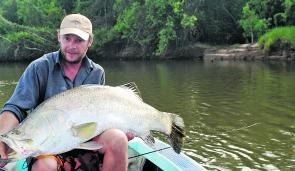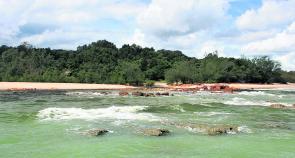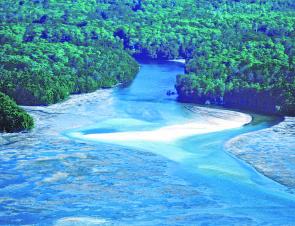March to May is my favourite time to fish the creeks, rivers and bays of Cape York. A thousand shades of green and grey is the best synopsis of these months and the fish just love it! All the contributing environmental factors will be coming to the forefront with extreme weather events, flooding and hot weather bolstering tropical food webs.
The larval stages of many crustaceans will mean a thick soup of life is being pushed out into the Gulf of Carpentaria and the east coast bays, ready to take a foothold in the ecosystem and do their thing as juniors wishing to become seniors. Life in the torrid waters of Cape York can be a very short-lived affair and almost every living creature is on the potential dinner menu for another, more veracious critter.
This is a time to use colourful presentations, vibrating sensations and every fancy wiggling and jiggling creation you can muster to entice hungry fish to switch things up and hit your artificial!
The offshore brigade will have a mixed time of it during March, with some gusty southeasterly blows, some northeasterly changes and some monsoonal trough activity producing rain and squalls at times. There will be some glamour weather mixed in there somewhere with a few days of doldrums providing a chance to get right out to outer reefs, shoals and wide patches to target the full range of reef-dwelling bruisers.
With barrramundi season now well and truly underway, estuary and river bound fishers will be praying for late rains, having already prayed for early rains and been a touch disappointed. A worrying distraction for fisher in the far north and right around our tropical coastline is the fluctuating wet seasons being received in recent years.
Far from being a dooms day prophecy, it must be acknowledged that wet seasons have probably fluctuated year in year out for millennia and beyond. What does become a problem however, is when year upon year, rivers and creeks fail to reach capacity, to break their tipping point and to reach flood levels necessary to drive recruitment of fish up and downstream from landlocked reservoirs. We have had a few wet seasons which have failed to measure up in recent years and a trend has seen them commencing later and later.
Sparse wet seasons coupled with barramundi gill net fishing in most of the major river systems on the west coast of Cape York can have a major impact on fish populations. Especially when breeding fish fail to find their way back upstream to the protection of freshwater lagoons, billabongs and isolated stretches of rivers. In seasons where this failure occurs, the tendency for gill nets to target a certain size-bracket of fish may have even further detrimental effects. It’s a real problem when that size bracket is fish between 70-100cm in length, which is the bulk of the spawning female population of barramundi!
This is why seasonal closures are so important and further reason why legislation and fisheries regulations in Queensland need to better represent the fish populations their are entrusted to protect. The fact Queensland still languishes so far behind the Northern Territory in regards to supporting the recreational fishing industry and buying back gill net licenses seems unthinkable when both environmental and economic considerations are weighed up.
Lets hope a change of government and the willingness of the general public to share knowledge and engage in advocacy at the grass-roots level brings about changes that see the recreational fishing sector get a massive bump upwards in priority. Most modern day fishers by their very nature are also conservationists in a sense. Most would love to see future generations enjoying the same opportunities they have had growing up with pristine fishing environments. Positive reinforcement of live-fish imagery coupled with a catch and release mentality is pushing sustainability right down to grass roots levels.
Lets keep up the positive imagery surrounding recreational fishing, take only what we plan to consume in the vey near future and continue to share knowledge and tips on how to make our sport the best it can be.
Reads: 963
A truly huge barra caught by the author during the March run-off.

Barramundi will hunt in locations where fresh meets salt.

Cape York's crocs will be lively and spread out in March, so take care.

Nutrient filled creeks flowing over flats to the sea is fishing paradise.




